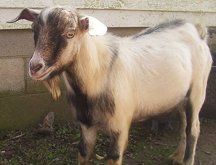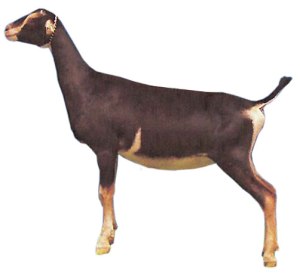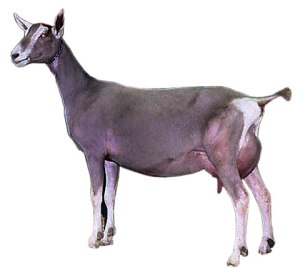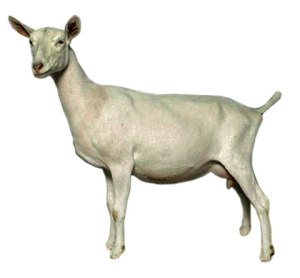I have carefully reviewed the several breeds that are out there and included here is a summary of each goat.
Dairy Goats:
Kinder
Origin: This is a fairly new breed especially promoted for homesteaders because of their small size. They are a registered cross between a Nubian doe and a Pygmy buck.Milk: In spite of their smaller size, they produce as much milk as the average larger goat (3/4 to 1 gallon per day) and the butterfat is high at 5-7%. They also tend to eat nearly as much as the larger goat in my experience =)They can also be used as meat goats.
Appearance: The Kinder is a midsize goat that is well proportioned in body length and legs. Its compact physique conforms to dairy characteristics despite its somewhat heavy bone and lean, yet well muscled structure. 100-120 pound does.
Personality: Great for a family with small children. The Kinder goat is a prolific, productive, alert, animated, good-natured and gregarious breed.
~~~~~~~~~~~~~~~~~~~~~~~~~~~~~~~~~~~~~~
Nubian

Origin: Nubians are a result of a cross-breeding in England many years ago between Indian, African and British goats.
Milk: They produce 3/4 to 1 gallon of rich, tasty milk per day that is second highest in butterfat of the dairy goats at 4.6%. The Jersey of the goat world.
Appearance: Nubians come in a variety of colors. They are beautiful goats, very regal and sophisticated looking with long, hanging ears. 130-135 pound does.
Personality: They are very sweet, but also quite vocal (if you have a herd of mixed goats, the nubians will be the ones you hear most often). I read that they can be stubborn, although ours weren’t. They tend to be flighty and high maintenance.
~~~~~~~~~~~~~~~~~~~~~~~~~~~~~~~~~~~~~
Mini-goats.
 These are a cross between a Nigerian Dwarf goat buck and any of the other Purebred does ~ in order to produce a smaller version. For example: A MiniNubian is a cross between a Nigerian Dwarf buck and Nubian doe. It takes a few generations of cross-breeding and the end result is intentionally a lower amount of the Nigerian Dwarf. The goal is for the goat to look like a mini-version of the breed, with the smaller characteristics of the Nigerian Dwarf.
These are a cross between a Nigerian Dwarf goat buck and any of the other Purebred does ~ in order to produce a smaller version. For example: A MiniNubian is a cross between a Nigerian Dwarf buck and Nubian doe. It takes a few generations of cross-breeding and the end result is intentionally a lower amount of the Nigerian Dwarf. The goal is for the goat to look like a mini-version of the breed, with the smaller characteristics of the Nigerian Dwarf.
~~~~~~~~~~~~~~~~~~~~~~~~~~~~~~~~~~~~~~~~
LaMancha.
Origin: A breed developed in the states in the 1900s.
Milk: Produce mild milk with 3.8% butterfat. Average of 1.5 gallons of milk per day.
Appearance: The goat with no ears. They actually do have ears, but they are very tiny. LaMancha goats come in a variety of colors. Average doe weight is 130 pounds.
Personality: Known for being very sweet and agreeable goats
~~~~~~~~~~~~~~~~~~~~~~~~~~~~~~~~~~~~~~~~~~~~
Toggenburg
Origin: Said to be the oldest pure breed. Originally from Switzerland.
Milk: Sources say that their 3.7% butterfat milk has a strong goaty flavor, which would be good for making goat cheeses such as feta or chevre. Produce 1.25 gallons per day.
Appearance: Their shaggy hair coloring is shades of brown in the body with unique facial markings and light feet. 120 pound does.
Personality: One of the more high strung breeds.
~~~~~~~~~~~~~~~~~~~~~~~~~~~~~~~~~~~~~~~~~
Golden Guernsey

Not very common in the states, in fact, I think there is only one breeder and she only sells bucks.
Origin: The breed was developed from local breeds mated to Anglo-Nubian and Swiss breeds
Milk: Average between 3/4 and 1 gallon of milk per day with a 3.72 butterfat
Appearance: Beautiful golden colored long hair.
Personality: Very docile and friendly
~~~~~~~~~~~~~~~~~~~~~~~~~~~~~~~~~~~~~
Saanen
Origin: Switzerland
Milk: This is the goat that is especially known for the volumes of milk it produces. The Holstein of the goat world. Very common in goat dairies. The milk is low fat at 3.52% and they produce 1 – 1.25 gallons per day.
Appearance: Pure white. Does weigh 145 or more.
Personality: A larger sweet-tempered goat . Can be headstrong.
~~~~~~~~~~~~~~~~~~~~~~~~~~~~~~~~~~~~~~
Alpine
 Origin: in France from Swiss stock
Origin: in France from Swiss stock
Milk: Their milk is 3.56% butterfat and tends to be more goaty. They produce 1- 1.25 gallons per day.
Appearance: These goats come in a variety of colors, but can not be pure white, Toggenburg colored or Oberhasli colored. Does weigh 125-135 pounds.
Personality: They have a sweet personality but can be headstrong and tend to be bossy. They make good cart-pulling goats.
~~~~~~~~~~~~~~~~~~~~~~~~~~~~~~~~~~~~
Nigerian Dwarf
Origin: A small goat of African descent.
Milk: A lot of people raise these as pets, but they do produce 1-2 quarts of very rich, sweet milk per day (similar to half and half). Nigerians have the highest butterfat content of all the purebred dairy goats at 6 and even up to 10%. Great milk for making rich ice cream, cheese and yogurt. =) Milk from a Nigerian Dwarf tastes sweeter and milder than other goat milk because of its higher milkfat content.
Appearance: They come in a variety of colors and are often known for their blue eyes. Mature does weigh 40 to 60 pounds; bucks weigh 40 to 70 pounds.
Personality: Nigerian Dwarf goats are gentle and easily trainable.
What to look for: make sure you ask to milk one to see if the teats are big enough for you to comfortably milk her
~~~~~~~~~~~~~~~~~~~~~~~~~~~~~~~~~~~~~
Oberhasli.
Origin: originated in Berne, Switzerland
Milk: It is said that you can’t tell Oberhasli sweet milk apart from cow’s milk. Butterfat content is 3.7 and up to 5%. Give anywhere from 3/4 to 1.5 gallons per day.
Appearance: A beautiful chamoisee or bay colored goat. Does weigh a minimum of 120 pounds.
Personality: Known for their gentle disposition Obers make great pack goats. I have heard they are active.
Meat Goats:
African Boer Goats

Have the long pendulous ears like a Nubian, bred from African goats mixed with European and Asian goats
~~~~~~~~~~~~~~~~~~~~~~~~~~~~~~
Spanish Goats

Also have pendulous ears, but shorter than the Nubian
~~~~~~~~~~~~~~~~~~~~~~~~~~~~~~~~
New Zealand Kiko Goats

Shorter pendulous ears, mixed breed of local wild goats and European goats
~~~~~~~~~~~~~~~~~~~~~~~~~~~~~~~~
Myotonic or Tennesse Goats

These goats are known for their fainting, unknown origin
~~~~~~~~~~~~~~~~~~~~~~~~~~~~~~
Pygmy

Pygmy goats are small goats of African origin. They are considered meat goats but are mainly used as pets. Often Agouti colored (black and white mixed as in the photo above)
Fiber Goats
Angora

The Angora goat originated in the district of Angora in Asia Minor and some are of Turkish origin. The Angora dates back prior to early biblical history. Angora goats are a medium-sized breed that grow very long curly coats, known as mohair. Angoras are fairly laid back and docile but not very hardy. The average goat in the U.S. shears approximately 5 pounds of mohair per shearing and are usually sheared twice a year. They produce a fiber with a staple length of between 12 and 15cm. They tend to be less hardy than other fiber goats in health and childbearing. Need to be wormed and de-loused regularly, depending on where you live. They need to have their horns as that is their cooling system.
~~~~~~~~~~~~~~~~~~~~~~~~~~~~~~~
Pygora

A Pygora goat is a cross purposely bred and then registered in Oregon by Katherine Jorgensen. She wanted an animal, which would produce fine fiber for hand spinning. She bred the Pygmy, a goat with short, soft down to the Angora, a goat with long silky fleece. Most Pygoras produce from 6 ounces to 2 pounds per shearing.
Type “A”: (Angora type)—A long, lustrous fiber up to 6 inches long, hanging in long, curly locks. The hair coat is not obvious on a type “A” animal. This fiber is very fine mohair. Some type “A”, “F1” Pygoras are single coated. These animals must be shorn.
Type “B”: (Blend type)—A blend of the Pygmy goat undercoat which is cashmere and the Angora mohair. It is between 3 and 6 inches long, and it has a nice crimp (curl). The second coat is usually obscured by the type “B” fleeces that is 3 to 6 inches long. Type “B” can either be lustrous (shiny), or have a matte (dull) finish. This fleece type is the most common, and these goats may be shorn, combed, or plucked.
Type “C “: (Cashmere type)—A very fine fiber, with no luster, and length of 1 to 3 inches. The hair coat looks very coarse in comparison to the two types above. Type “C” can be acceptable commercial cashmere. These goats may be shorn or combed.
~~~~~~~~~~~~~~~~~~~~~~~~~~~~~~~~~~~~~~~~~~~~~~~~~~~~~~~~~~~~~
Cashmere

A cashmere goat is any type of goat that produces cashmere wool; the goats are most often bred for commercial use. Cashmere wool grows as the goat’s winter undercoat, which is then covered by a second layer of coarser hair, called guard hair. A single goat can produce about 4 ounces of wool annually, which tells you why cashmere is so expensive. There are 11 breeds of goat that are raised to produce cashmere wool.
~~~~~~~~~~~~~~~~~~~~~~~~~~~~~~~~~~~~~~~~~~~~~~~~~
Which type is best? It depends on who you ask. Every breeder thinks their goats are the best. =)
A goat with solid conformation from a reputable breeder will sell for quite a bit more than a goat that is the result of breeding only to get a milking doe. Well-bred does will generally live longer, produce more milk, have an easier time kidding and live a healthier life.
MILK COMPARISONS
Compare how much cheese from one gallon of milk between Nubian and Nigerian
This episode is cheerfully sponsored by:
Save $1,0000s on your next car lease – always $0 cash down…
delivered to your home (or office)






